The Bagpipe Society
Expedition in the North - Part 2
Dear readers, welcome to the second part of my article for Chanter magazine. This article is about my artistic research project: Expedition in the North
- Logbook from a Belgian bagpiper. I wrote a paper about this project as part of my Nordic Master in Folk Music studies (2017-2019).
In the first part of the article, (see the last edition of Chanter), I wrote a brief personal summary of the history/geography of the bagpipe in the Nordic countries. I also gave an insight into my own musical background and in the role of the bagpipe in the Belgian folk music scene. In the second part of my article you will experience how these two worlds meet: the Nordic folk environments and my Belgian bagpipe identity. I will talk about my “Expedition in the North”.
First I give background information about the expedition and my logbooks. After this I discuss some of my main expedition results and findings from the different countries that I visited.
The Expedition
On the 27th of August 2017 at 17:20 I left Belgium to start my new adventure: the Nordic Master in Folk Music. For two years I travelled around the Nordic countries, where I studied, listed in chronological order, at the folk departments of the Kungliga Musikhögskolan in Stockholm (Sweden), the Syddansk Musikkonservatorium in Esbjerg (Denmark), the Sibelius Academy in Helsinki (Finland) and the Ole Bull Akademiet in Voss (Norway). I left Belgium with three backpacks: one with my clothes, one with my instruments (musette and Flemish/French bagpipes) and one with my Belgian bagpipe
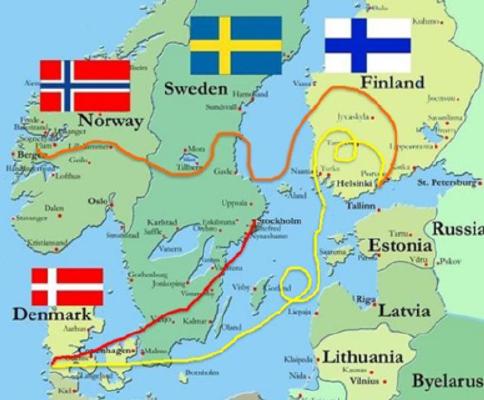
In order to “survive” this trip I had to discover my own bagpipe identity in the Nordic folk music traditions. I wanted to find out two things: “Which Nordic folk music repertoire could be useful for me as a bagpiper?” and “Which musical tools from the living Nordic folk music environments could I apply to my bagpipe playing?”. For two years I tried to find answers to these questions by diving into archive material and getting into contact with different folk music environments and musicians (bagpipers and other instrumentalists). As a result I kept a logbook with my discoveries and experiences, accompanied by audio / video recordings and interviews that I made along the way.
From the start of the expedition I tried to have an open mind-set in order to receive a broad picture of the repertoire and musical tools.
“Gathering a good selection of tunes suitable for the instrument, while maintaining an open mind, has been an issue close to my heart” (Petri Prauda)
The Logbooks
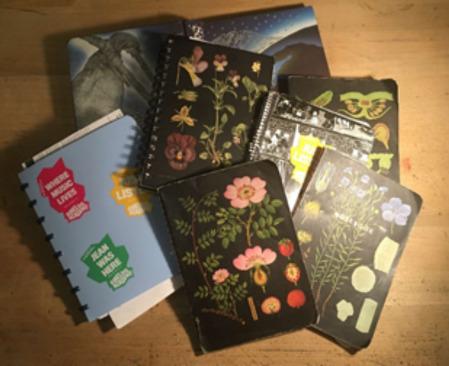
Throughout the two years I wrote my thoughts, discoveries and experiences about my two research questions down in several little logbooks (9 in total). Together with these books I collected a treasure of pictures, recordings, interviews and videos. I selected 13 videos and made them into a series called Nordic Folk Music on Bagpipes. This series you can find as a playlist on my YouTube Channel: Marieke Van Ransbeeck (https://bit.ly/NordicFolkonBagpipes). In these videos you can see me playing solo or together with musicians that I met during the expedition.
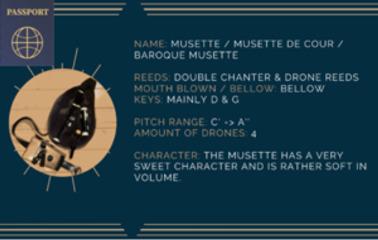
In order to be well prepared for this expedition, I added some essential things in my backpack: bagpipe passports for my musette and Flemish/French bagpipes, decent recording equipment (iPhone, Zoom-recorder and tripods) and humidity devices. The climate in the North, especially in the winter, is much drier than in Belgium. I tried to prevent some catastrophes (like a broken reed) by having:
humidifiers in my bagpipe cases, a humidity meter and a towel to wrap around my bagpipes. In extreme weather cases I made the tip of the towel wet, which really helped for keeping the reeds humid enough.
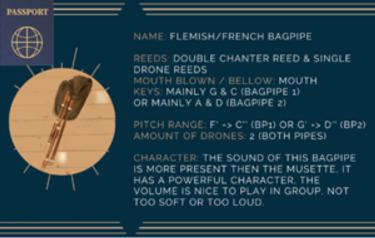
I took three different bagpipes on my expedition. The musette I used is actually a “bass musette” and is tuned a bit lower than a standard musette. At 440hz, the instrument is tuned in D/G (ground note d’). Then I also brought two Flemish/French bagpipes, one tuned in G/C (ground note g’) and one in A/D
(ground note a’). It was good to have different instruments in different keys with me.
I collected a lot of material during the two-year study and I had to make a selection of the material in order to highlight my main findings. In this article I will discuss some of these main findings by talking about repertoire I found and the musicians that I met. These findings illustrated with videos from the series .
With regard to my search for repertoire in the archives, I’ve chosen only to focus on tunebooks and not on recordings. The results of this expedition show my personal overview of possible repertoire and musical tools on the bagpipe. Other suitable repertoire and musical tools probably exist in the Nordic region, but did not cross my path or I did not focus on them.
Sweden
Archive Treasure
According to Olle Gällmo (website), little is known about the tunes played by the old Swedish bagpipers, nor how they played them. There is a short list of tunes known to have been played by bagpipers, but all of them passed through other instruments on their way down to us. Olle gives the advice to go through the treasure of Swedish traditional music and search for the fraction of tunes that are playable.
This treasure is huge! In Sweden there is a lot of archive material, mostly starting from the 18th century. One example is the Svenska Låtar. This collection has 24 volumes full of music from different areas in Sweden. More specifically there have been “new” collections made for the bagpipe. For example, in the book Säckpipan i Norden you can find several bagpipe tunes in the chapter " Tycker sig höra påsens trolska klang… “, written by Stig Norrman. The website of Olle Gälmo is also worth a visit, because there he mentions lots of bagpipe repertoire and also the collections he has compiled himself, like a compilation of 25 tunes from Petter Dufva.
According to Sven Ahlbeck (1989), the Swedish traditional repertoire makes a distinction between two different tonal languages: modal and harmonic music.
Modal music is when there is a relation between the notes and one or more reference notes, a so-called drone. This is the music from the old traditions like Fäbodsmusik, Kulning, and Vallåt. In harmonic music, structures of sequences become clear because the individual notes have a relation with the chords. This is the so-called new repertoire found in fiddle music. Obviously, for a drone instrument it would be a good start to look into modal music.
During my stay in Sweden I also bought a säckpipa (Swedish bagpipe) from the bagpipe builder Max Persson. The instrument is tuned in E/A (ground note e’). This made it possible for me to play along with melodies in E or A, and dive more into the säckpipa style and repertoire.
Ellika Frisell
The first musical tool that came on my path was the use of bowings.
Ellika Frisell is a fiddle player and she encouraged me to find a way for translating bowings of a fiddle into my bagpipe playing. From this moment I will also use the word slurs instead of bowings, because I’m not using a bow when I play the bagpipe. As a bagpipe player, I had never really thought about the use of slurs when playing folk music. I decided to work on slurs mainly with my musette, because I’m used to playing slurs on this instrument in Baroque 33
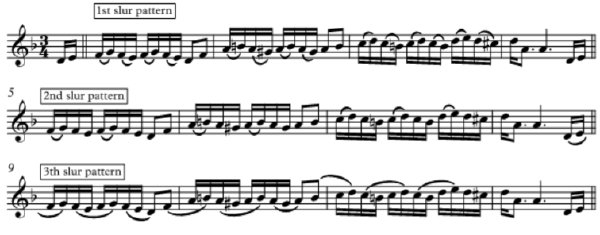
repertoire. When you articulate a note on the musette, then you always play the bottom d’ before that note. You leave out the bottom note d’ to make slurs between the notes. Ellika advised me to make my own exercises to practice slurring. The tune Kringeleek is perfect to practice different slur patterns.
VIDEO Nordic Folk Music on Bagpipes: Kringeleek
Anders Norrude
I met Anders twice, once at his home in Vårmland and once at the Ränsäter stämma in 2018. I totally love his groovy playing on the Swedish bagpipe. He taught me some good säckpipa tunes. In the video I play the tune Kringeleek together with one of the tunes I learned from Anders: Säckpipslåt från Norra Råda.
VIDEO Nordic Folk Music on Bagpipes: Kringeleek and Säckpipslåt från Norra Råda.
Denmark
Keld Nørgaard
The late Keld Nørgaard (the key person of the bagpipe revival in Denmark) told me in an interview (May 2018): “We don’t have many bagpipe tunes, there are not really written tunes for the bagpipe”. Like in Sweden I had to dive in the archive material in order to find some bagpipe-friendly tunes. I have been mostly looking at two manuscripts from the mid 18th century: one from Rasmus Storm (Funen) and one from the Bast brothers (Lolland). From these two notebooks I found a few tunes that fit the bagpipe (both musette and Flemish/French bagpipes). Sometimes I had to make small adjustments, mostly by changing the key or a small adjustment to the melody. Although Keld didn’t think that Rasmus Storm’s notebook is a good book to look for bagpipe tunes, I only partly agree with him: a lot of archive material is from a time where the 34
violin totally overshadowed the drone instruments. But I think it’s also fun to look into these books and find maybe new interesting bagpipe melodies. The other tune books that Keld suggested are: Erik Jensens manuscript (1790) and two books from H. Grüner Nielsen: Folkelig Vals(1920) and Vore Ældste Folkedanse (1917).
In the 90’s Keld Nørgaard and Poul Lendal also published a new tunebook called: Dronebogen (1991) . In this book they collected drone-friendly tunes. Nowadays you can get this book from Dronemusik Danmark.
A solution for bagpipe repertoire is, of course, to compose tunes yourself.
Keld Nørgaard has been composing and arranging as long as he can remember.
One of the tunes he composed on the bagpipes is called Anglaise and has become a hit in the Danish folk scene. I recorded this tune with the musette, because then I could add some double stops (playing on the two melody chanters at the same time), which you can hear in the video.
VIDEO Nordic Folk Music on Bagpipes: Anglaise
Kristine Heebøll
In the Danish folk environment you also have lots of tunes with a key change. This can be a problem for drone-instruments, because there’s always a drone sounding. I wanted to find out if there are tunes with key changes that would fit anyway on the bagpipes. Kristine, a fiddle player and my main instrument teacher at SDMK Esbjerg, taught me a Polka from Læsø. This tune has a key change from G major to D major. In the video we play this tune in two different keys: G major (where it modulates to D major in the tune) and D-major (where it modulates to A major in the tune). I also change my drones between the two versions, because I feel that it fits better to have the fifth sounding when the tune modulates to the fifth in the B-part. So when I play in D, an A-drone is sounding and when I play in G, a D-drone is sounding.
VIDEO Nordic Folk Music on Bagpipes: Polka from Læsø Sønderhoning Repertoire
During the spring and summer of 2018 and 2019 I lived on the island of Fanø. From the start I was totally enchanted by the place. Besides the beautiful fairy-tale houses, they also have a vibrant folk music scene both in the towns Sønderho and Nordby. I’m very attracted to the sønderhoning (a dance from Sønderho) repertoire, because I love to play these tunes on the bagpipe. The tunes have a drony character, a small melodic range and there are lots of slides between the notes: an excellent musical habitat for a bagpiper. I received a broad view from the sønderhoning repertoire by having meetings with fiddlers Tove De Fries and Peter Uhrbrand.
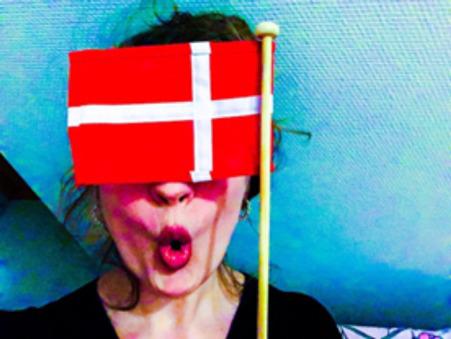
Tove De Fries
Tove De Fries taught me a lot of different tunes from the sønderhoning repertoire. When learning this repertoire the main challenge for me was the timing of the notes. In the music there’s a constant game between delayed and earlier placed notes. This gives a stretched character and certain tension to the music. It was good to practice the timing while playing for dancers and while dancing a sønderhoning myself too.
For playing the sønderhoning repertoire I mainly used my Flemish/French bagpipes in G and A. In the following video’s I’m playing some sønderhonigs with Tove, one with the G-bagpipe and one with the A-bagpipe.
VIDEO Nordic Folk Music on Bagpipes: Fisken liggen på hviden sand VIDEO Nordic Folk Music on Bagpipes: Æ Hollænder.
Finland
Archaic Repertoire
There is lots of archive material in Finland, but unfortunately I didn’t find any music that is written for the bagpipes or was played on bagpipes. Like in Sweden and Denmark I had to look for clues which repertoire from the archive would fit.
In Finland they make a distinction between the archaic repertoire and the spelmans repertoire. It’s comparable to the distinction I mentioned earlier between the modal and harmonic music. The music from the archaic repertoire is modal, has a drony character and has melodies with a small range. The music from the spelmans repertoire is harmony based, violin-friendly and has melodies with a bigger range. I found some interesting tunes from the archaic tradition, especially from the jouhikko, kantele and lament/hymne repertoire. This repertoire fits really nice in the drony bagpipe world. Some interesting collections are: Karjasoitto (1985) and Kantele-ja Jouhikkosävelmiä (2002), both books are modern publications from A.O. Väisänens collections. And then you also have The Bowed Lyre: Jouhikko from Rauno Nieminen (2017).

Petri Prauda
Through my meetings with bagpipe player Petri Prauda, I learned a new way of adding cuts to my bagpipe playing. You make a cut (ornament) on a bagpipe by quickly lifting a finger higher than the melody note. Petri showed me how to use cuts in a more varied way. When playing for example a polska you can vary the rhythmical layers by placing the cuts in different places: 1) on the first and third beat, 2) on all the beats or 3) only on the backbeat. I really like the use of cuts on the backbeat, because normally I would mostly use them on the beat.
Petri also taught me lots of great bagpipe tunes that are collected on the album of his band Päre: Hausjärvi Beat. One of those tunes is the Karhunpeijaispolska. Through this tune we worked on accenting the backbeats in the melody. On the score you can see where we’ve placed the cuts. In the video fragment I play the Karhunpeijaispolska with Leija Lautamaja, a fabulous melodeon player that I met on my trip in Finland.
VIDEO Nordic Folk Music on Bagpipes: Karhunpeijaispolska
Norway
Repertoire Search
During my stay in Norway there was again no sign of repertoire written for bagpipes. So I’ve been mainly meeting musicians and trying to find out which repertoire from the instruments used in the Norwegian folk music traditions could be useful for me as a bagpiper. Three instruments popped out very fast: the mouth harp, the langleik (hummel) and the Hardanger fiddle. These instruments have a drony character: overtones from the mouth harp, drone string from the langleik and resonance strings and double stops from the Hardanger fiddle.
Håkon Asheim
Because I wanted to learn Hardanger repertoire on the bagpipes I had some meetings with Hardanger fiddler Håkon Asheim. He taught me a halling from Valdres, the place in Norway where he comes from. The tune is called Grokinn Halling. Typical of the Hardanger fiddle repertoire is that the tunes are built from different motifs. You’re free to play with the motifs and repeat them as long as you want or change the order of the motifs. Håkon taught me the Grokinn Halling in D-major. In the video you will see that I also play this halling in G-major. I transposed the tune because I think it fits better in that key on the musette.

VIDEO Nordic Folk Music on Bagpipes: Grokinn Halling Tellef Kvifte
During my expedition Tellef Kvifte was one of the few bagpipers who could tell me his opinion about translating fiddle tunes on the bagpipe. He explained to me in an interview that he first played the Hardanger fiddle. In the search for a wind instrument that would fit to the Hardanger repertoire, he started playing the bagpipe. According to Tellef most tunes from this repertoire have an ambitus of two octaves, where the lower octave is in D major and the higher octave has a high 4th (bluenote). So he decided, in order to play these tunes on the bagpipe, to cut the tunes in two pieces (low and high octave). And play the upper octave material one octave down. The Swedish bagpipe builder Alban Faust made him a bagpipe in D with a key to swap easily between the c''
and cis’’ (the high 4th). Most Hardanger tunes are in D, but Tellef mainly transposes them to G. According to him, and also to me, they fit better in that key on a bagpipe tuned in D.
Tellef tells me that the most important thing when he translates Hardanger tunes to the bagpipe are the bowing patterns. He uses cuts to translate them to the bagpipe. The score below shows a motif section from the halling from Tørdal, a tune Tellef taught me. You can see the cuts in the melody in order to translate the bowing patterns from the Hardanger fiddle.
We recorded this halling during my stay at Rauland. Because it was still winter in Rauland, the air was very dry. In the background of the video you can spot a humidifier to create some humid air in the room. Unfortunately the day before we recorded, Tellef broke his drone. Because he was not able to repair it for the video, we only play with the drones from the musette.
VIDEO Nordic folk Music on Bagpipes: Halling from Tørdal Sjur Nyvold
When I was in Rauland I also met the young mouth harp player: Sjur Nyvold. It was so wonderful to discover that the musette and the mouth harp fit well together. The musette provides a clear melody and the mouth harp a clear rhythmical layer. We played for dancing during one of the evenings in Rauland, and I must tell you that I felt super badass with such a groovy mouth harp player beside me. In the video you can hear two gangar tunes from Rauland that he taught me.
VIDEO Nordic Folk Music on Bagpipes: Gangars from Rauland Expedition Conclusion
Through this research, this expedition, I have a personal overview of the folk music repertoire from Sweden, Denmark, Finland and Norway that is useful for me as a bagpiper. Although there is not much written music for the bagpipe in these Nordic countries, I was able to find an interesting repertoire from archive material and by meeting different musicians, both bagpipers and other instrumentalists. Through these meetings I also gained new / developed musical tools which I can apply to my bagpipe playing and musical language.
When looking at the folk music repertoire in all the Nordic countries I noticed that there are two different types of repertoire: modal and harmony-based repertoire. In Finland they call these two types in that order the archaic repertoire and the spelmans reperoire. In my opinion the bagpipe fits very well in this archaic repertoire. But it’s also worth having a look into the spelmans repertoire. This search is a bit harder because the music from this repertoire has mostly a big range (violin range) and / or changes key. But it’s not impossible, because I found some tunes that fit like the Halling from Tørdal and the Polka from Læsø. Sometimes I had to make small adjustments to the melody: change the key, change octaves for some parts, play alternative melody notes, etc.
I’m very happy that I took my bagpipes (musette and Flemish/French bagpipes) with me on this expedition. Which one I played depended on the type of repertoire, key and situation. Mainly I used the musette because of its: 1) wide chromatic range, 2) smooth and soft character, 3) possibilities according to slurring, 4) possibilities of the drones, 5) possibility of playing double stops, and 6) the key possibilities. In general the two most frequently used keys that I encountered, regardless of the mode in which the music was played, were G and D. These are the two main keys on my musette. I’m used to playing mainly baroque music on this instrument, but since my trip I’m totally up to discover its folk side. On the other hand it was also very handy to have my Flemish/French bagpipes with me, especially to play the sønderhoning repertoire.
It was wonderful to meet different musicians, both bagpipe players and other instrumentalists. As a recommondation, I can advise any bagpipe player to meet and have lessons with other instrumentalists (fiddlers, accordion players, mouth harpists…). With their knowledge you will experience music and musical tools in a new way.
Dear readers, I’m very happy I could share my discoveries and experiences from this expedition with you through these articles. I hope you enjoyed the trip and that I could maybe motivate you to start your own expedition too. In this article I only focused on some main findings. Feel free to contact me if you would like some more information about my research or if you would have further questions. All the videos from my research you can find in the YouTube playlist: Nordic Folk music on Bagpipes. You can also find more info about me and my bagpipe adventures on my website:
www.mariekevanransbeeck.com and Social Media pages (YouTube, Facebook and Instagram). Until we meet again, may the drone be with you!
References
Ahlbäck, S. (1989). Tonspråket i äldre svensk folkmusik. Stockholm: Udda Toner.
Gällmo, O. (2019). Swedish Bagpipes – Olle Gällmo. Website: http://olle.gallmo.se/sackpipa/
Prauda, P. (2019). About Petri Prauda on etno.net. Website: https://etno.net/node/314
- Data Processing Notice (GDPR)
-
@BagpipeSociety on X (formally known as Twitter)
-
TheBagpipeSociety on Instagram
-
 BagpipeSociety on Facebook
BagpipeSociety on Facebook
Something wrong or missing from this page? Let us know!
